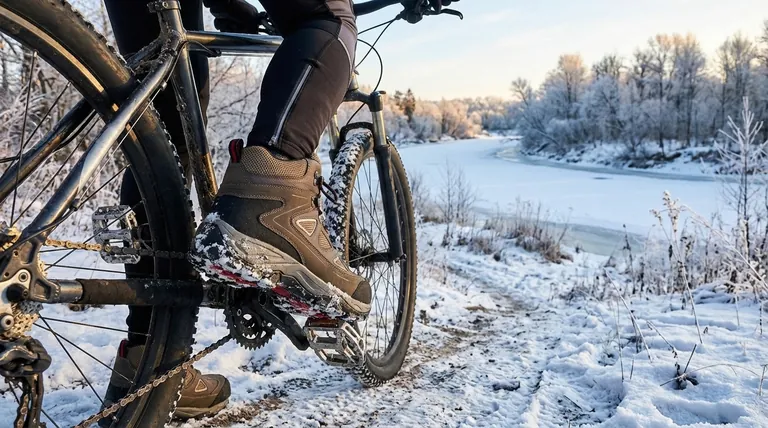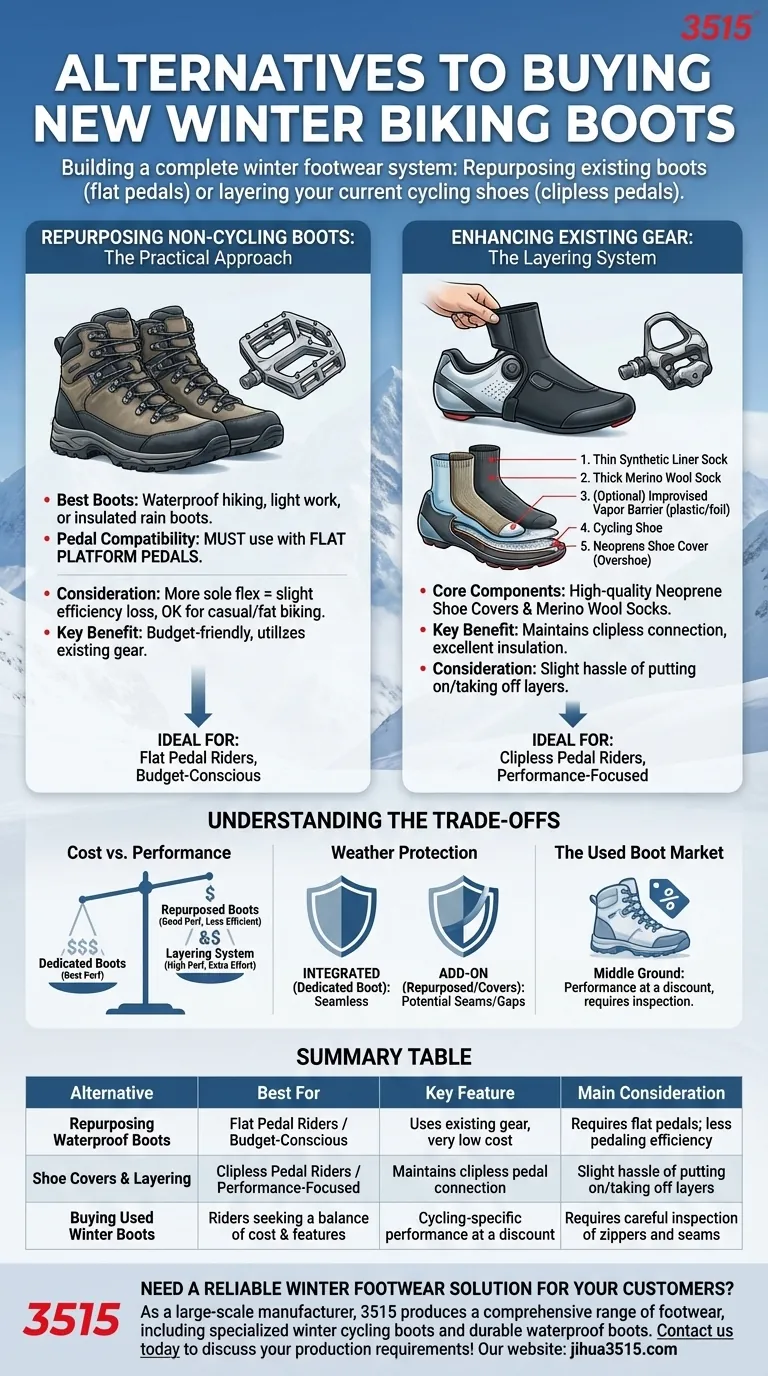Ultimately, the best alternatives to buying new winter biking boots are either repurposing existing waterproof boots you already own or upgrading your current three-season cycling shoes with high-quality shoe covers. Both approaches can be highly effective and cost-efficient, but they serve different types of riders and pedal systems.
Your goal isn't just to find an alternative, but to build a complete footwear system. You can achieve warmth and weather protection comparable to dedicated winter boots by thoughtfully combining non-cycling boots with the right pedals or by layering your existing gear correctly.

Repurposing Non-Cycling Boots: The Practical Approach
The most common and budget-friendly alternative is to use a pair of boots you may already own. This strategy is best suited for riders who use flat pedals.
### The Best Boots to Repurpose
Look for waterproof hiking boots, light work boots, or even insulated rain boots. The ideal boot has a relatively stiff sole for better power transfer to the pedals and isn't excessively bulky, which can interfere with your crank arms.
### The Pedal Compatibility Problem
This is the most critical factor. Non-cycling boots do not work with clipless pedals. You must use them with flat platform pedals, preferably ones with metal pins that can grip the boot's rubber sole for a secure connection, even in wet or snowy conditions.
### Managing Sole Flex and Feel
A hiking boot's sole is designed for walking, meaning it has more flex than a cycling shoe. This results in a slight loss of pedaling efficiency, but for casual winter riding, commuting, or fat biking, it's a perfectly acceptable trade-off.
Enhancing Your Existing Gear: The Layering System
If you want to continue using your current cycling shoes and clipless pedals, the best alternative is not a different boot, but a system of layers built around your existing shoes.
### Waterproof Shoe Covers (Overshoes)
This is the single most effective upgrade. High-quality neoprene shoe covers are the industry standard, acting as a wetsuit for your feet. They insulate exceptionally well even when damp and provide a nearly impenetrable barrier against wind and water.
### Strategic Sock Selection
Never wear cotton socks. A good system involves a thin, moisture-wicking liner sock made of a synthetic material, covered by a thicker, insulating merino wool sock. This combination wicks sweat away while trapping warm air.
### Improvised Vapor Barriers
For extreme cold, a classic cyclist trick is to place a plastic bag or a piece of aluminum foil between your sock layers. This acts as a vapor barrier, stopping wind completely and preventing evaporative heat loss from your insulating sock layer.
Understanding the Trade-offs
Choosing an alternative to dedicated boots involves balancing cost, convenience, and performance. There is no single perfect solution.
### Cost vs. Performance
Dedicated winter cycling boots offer the best performance with stiff soles, clipless compatibility, and integrated weatherproofing. However, they carry a high price tag. Alternatives are significantly cheaper but come with compromises in pedaling efficiency (repurposed boots) or the slight hassle of putting on layers (shoe covers).
### Weather Protection: Integrated vs. Add-On
A winter cycling boot provides seamless protection from the sole to the ankle. When repurposing hiking boots, you create a potential weak point where your pants meet the boot top. Similarly, shoe covers create a seam at the bottom (cleat opening) and top that can eventually let water in during a downpour.
### The Used Boot Market
A viable middle ground is to search for used winter cycling boots. You can often find high-quality, lightly used boots on online marketplaces at a significant discount, giving you the performance benefits without the full retail cost. Always inspect zippers and seams for wear and tear.
Choosing Your Winter Footwear Strategy
Your ideal solution depends entirely on your goals, budget, and current equipment.
- If your primary focus is the lowest possible cost and you use flat pedals: Repurposing a pair of waterproof hiking or work boots you already own is your most effective option.
- If your primary focus is performance and you want to keep your clipless pedals: A system of high-quality neoprene shoe covers combined with merino wool socks is the best alternative.
- If your primary focus is finding a balance of cost and cycling-specific features: Patiently searching the used market for dedicated winter cycling boots is a fantastic strategy.
By understanding these options and their trade-offs, you can confidently build a winter footwear system that keeps you warm, dry, and riding all season long.
Summary Table:
| Alternative | Best For | Key Feature | Main Consideration |
|---|---|---|---|
| Repurposing Waterproof Boots | Flat Pedal Riders / Budget-Conscious | Uses existing gear, very low cost | Requires flat pedals; less pedaling efficiency |
| Shoe Covers & Layering | Clipless Pedal Riders / Performance-Focused | Maintains clipless pedal connection | Slight hassle of putting on/taking off layers |
| Buying Used Winter Boots | Riders seeking a balance of cost & features | Cycling-specific performance at a discount | Requires careful inspection of zippers and seams |
Need a Reliable Winter Footwear Solution for Your Customers?
As a large-scale manufacturer, 3515 produces a comprehensive range of footwear for distributors, brand owners, and bulk clients. Whether you need specialized winter cycling boots, durable waterproof boots perfect for repurposing, or other types of shoes and boots, our production capabilities cover all your needs.
Let us help you equip your customers for the cold season. Contact us today to discuss your production requirements!
Visual Guide

Related Products
- Safety Footwear Wholesale Manufacturer for Custom OEM/ODM Production
- Factory Direct Wholesale Rain Boots Durable Waterproof & Fully Customizable
- High Performance Fire-Retardant Waterproof Safety Boots
- Factory-Direct Wholesale Canvas Boots with High-Traction Rubber Soles
- Premium Wholesale Waterproof Safety Boots High Performance Protection for Industrial Markets
People Also Ask
- What are the cultural perspectives on wearing shoes in the house? A Guide to Home Etiquette & Hygiene
- How do safety shoes contribute to cost savings for companies? A Strategic Investment in Risk and Cost Management
- Is safety-toe as good as steel toe? Choose the Right Protection for Your Job
- What cultural and environmental considerations are tied to wearing shoes indoors? Balance Hygiene, Tradition, and Foot Health
- Do snake bite boots work? Your Ultimate Guide to Effective Snake Bite Protection



















